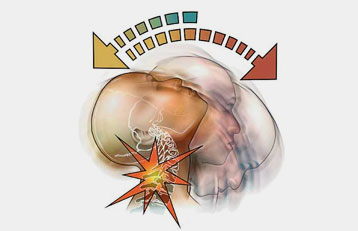Whiplash Injury

Whiplash injury is real and potentially serious. The rapid force of impact causes injury in less than a second: quicker than your muscles can react to protect your neck.1
Depending upon many different factors, there are multiple structures in the neck that are damaged in a whiplash injury. Some of the more common include: the facets (joints between vertebra) and their ligamentous capsules, discs, nerves, blood vessels, muscles and ligaments.
These injured areas can produce pain immediately after the collision, or it may take a few days to couple weeks to develop symptoms. Left untreated or improper treatment, they can develop into a chronic and degenerative pain cycle.
When examining someone who has been in an car accident, careful attention must be given to verify or eliminate such conditions as: spinal vertebrae fractures, disc herniation, nerve root irritation or even concussion.
Common signs and symptoms of whiplash neck injury?
Symptoms of whiplash neck injury vary depending upon what structures have been damaged. In general, neck pain and stiffness are the most common. Other symptoms include:
• Headaches
• shoulder pain
• dizziness,
• jaw pain
• arm pain/weakness
• visual disturbances
• ringing in the ears
• back pain
• sleep disorders
Research has shown that chiropractic care can be the most effective form of treatment for whiplash injury.
The following are various articles regarding the complexity of car accidents and whiplash injury
- What Are Whiplash Injuries?
- Head Rotation Increases Force Of Impact
- Injury Proven At 4km/h Impact
- Auto Accidents: Disc Injuries & MRI’s
